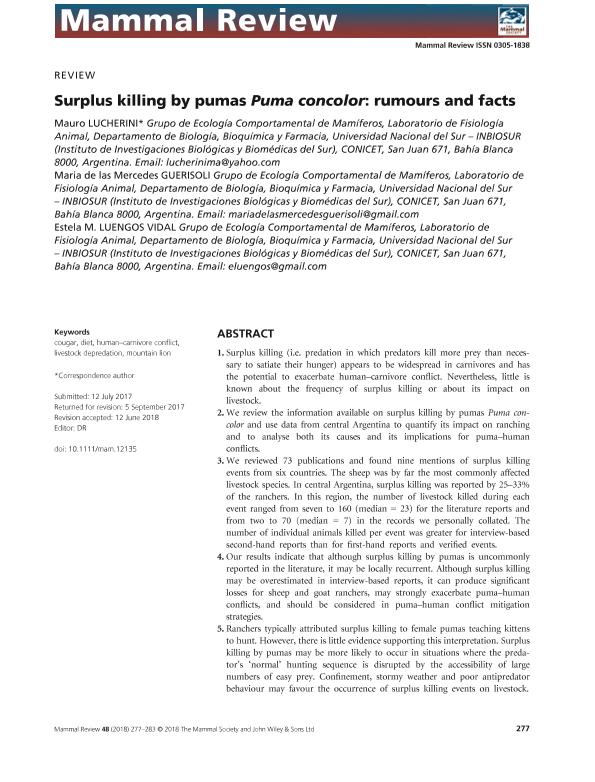Mostrar el registro sencillo del ítem
dc.contributor.author
Lucherini, Mauro

dc.contributor.author
Guerisoli, Maria de Las Mercedes

dc.contributor.author
Luengos Vidal, Estela Maris

dc.date.available
2019-11-05T18:05:53Z
dc.date.issued
2018-07-26
dc.identifier.citation
Lucherini, Mauro; Guerisoli, Maria de Las Mercedes; Luengos Vidal, Estela Maris; Surplus killing by pumas Puma concolor: rumours and facts; Wiley Blackwell Publishing, Inc; Mammal Review; 48; 4; 26-7-2018; 277-283
dc.identifier.issn
0305-1838
dc.identifier.uri
http://hdl.handle.net/11336/88043
dc.description.abstract
Surplus killing (i.e. predation in which predators kill more prey than necessary to satiate their hunger) appears to be widespread in carnivores and has the potential to exacerbate human–carnivore conflict. Nevertheless, little is known about the frequency of surplus killing or about its impact on livestock. We review the information available on surplus killing by pumas Puma concolor and use data from central Argentina to quantify its impact on ranching and to analyse both its causes and its implications for puma–human conflicts. We reviewed 73 publications and found nine mentions of surplus killing events from six countries. The sheep was by far the most commonly affected livestock species. In central Argentina, surplus killing was reported by 25–33% of the ranchers. In this region, the number of livestock killed during each event ranged from seven to 160 (median = 23) for the literature reports and from two to 70 (median = 7) in the records we personally collated. The number of individual animals killed per event was greater for interview-based second-hand reports than for first-hand reports and verified events. Our results indicate that although surplus killing by pumas is uncommonly reported in the literature, it may be locally recurrent. Although surplus killing may be overestimated in interview-based reports, it can produce significant losses for sheep and goat ranchers, may strongly exacerbate puma–human conflicts, and should be considered in puma–human conflict mitigation strategies. Ranchers typically attributed surplus killing to female pumas teaching kittens to hunt. However, there is little evidence supporting this interpretation. Surplus killing by pumas may be more likely to occur in situations where the predator's ‘normal’ hunting sequence is disrupted by the accessibility of large numbers of easy prey. Confinement, stormy weather and poor antipredator behaviour may favour the occurrence of surplus killing events on livestock.
dc.format
application/pdf
dc.language.iso
eng
dc.publisher
Wiley Blackwell Publishing, Inc

dc.rights
info:eu-repo/semantics/openAccess
dc.rights.uri
https://creativecommons.org/licenses/by-nc-sa/2.5/ar/
dc.subject
COUGAR
dc.subject
DIET
dc.subject
HUMAN–CARNIVORE CONFLICT
dc.subject
LIVESTOCK DEPREDATION
dc.subject
MOUNTAIN LION
dc.subject.classification
Ecología

dc.subject.classification
Ciencias Biológicas

dc.subject.classification
CIENCIAS NATURALES Y EXACTAS

dc.title
Surplus killing by pumas Puma concolor: rumours and facts
dc.type
info:eu-repo/semantics/article
dc.type
info:ar-repo/semantics/artículo
dc.type
info:eu-repo/semantics/publishedVersion
dc.date.updated
2019-10-24T18:19:40Z
dc.journal.volume
48
dc.journal.number
4
dc.journal.pagination
277-283
dc.journal.pais
Estados Unidos

dc.journal.ciudad
Hoboken
dc.description.fil
Fil: Lucherini, Mauro. Consejo Nacional de Investigaciones Científicas y Técnicas. Centro Científico Tecnológico Conicet - Bahía Blanca. Instituto de Ciencias Biológicas y Biomédicas del Sur. Universidad Nacional del Sur. Departamento de Biología, Bioquímica y Farmacia. Instituto de Ciencias Biológicas y Biomédicas del Sur; Argentina
dc.description.fil
Fil: Guerisoli, Maria de Las Mercedes. Consejo Nacional de Investigaciones Científicas y Técnicas. Centro Científico Tecnológico Conicet - Bahía Blanca. Instituto de Ciencias Biológicas y Biomédicas del Sur. Universidad Nacional del Sur. Departamento de Biología, Bioquímica y Farmacia. Instituto de Ciencias Biológicas y Biomédicas del Sur; Argentina
dc.description.fil
Fil: Luengos Vidal, Estela Maris. Consejo Nacional de Investigaciones Científicas y Técnicas. Centro Científico Tecnológico Conicet - Bahía Blanca. Instituto de Ciencias Biológicas y Biomédicas del Sur. Universidad Nacional del Sur. Departamento de Biología, Bioquímica y Farmacia. Instituto de Ciencias Biológicas y Biomédicas del Sur; Argentina
dc.journal.title
Mammal Review

dc.relation.alternativeid
info:eu-repo/semantics/altIdentifier/url/https://onlinelibrary.wiley.com/doi/abs/10.1111/mam.12135
dc.relation.alternativeid
info:eu-repo/semantics/altIdentifier/doi/http://dx.doi.org/10.1111/mam.12135
Archivos asociados
